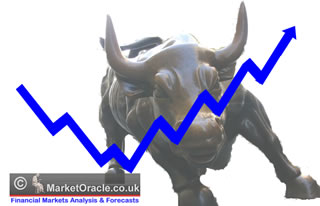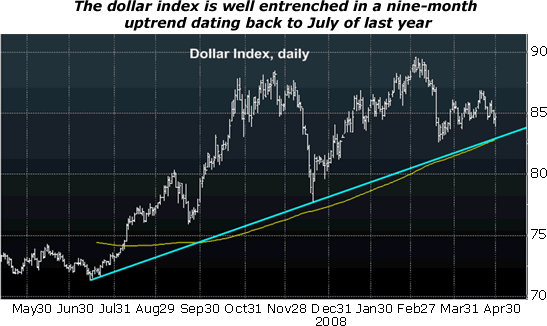Economic Recovery Plan Doomed to Fail as Optimists Fuel Bear Market Rally
Stock-Markets / Financial Markets 2009 May 02, 2009 - 05:23 AM GMT Bryan Rich writes: It’s important to understand the global investment and economic environment to understand what’s going on with currencies. And right now, there’s limited visibility of what lies ahead for world economies …
Bryan Rich writes: It’s important to understand the global investment and economic environment to understand what’s going on with currencies. And right now, there’s limited visibility of what lies ahead for world economies …
Do things return to normal? OR has a major adjustment taken place? And in the case of the latter, are we in for a sustainably lower standard of living, sustainably lower asset prices and sustainably lower levels of certainty?
Many in the optimistic camp believe “recovery” is a return to normalcy. This means a resurgence in home values, climbing stock markets, a healthy job market, strong incomes, a return to easy credit … all the things Americans have grown accustomed to over the years of bullish equity markets and strong economic conditions. In short, the optimists expect a full restoration of lost wealth.
 |
| The optimists have fueled a bear market rally and expect a full restoration of lost wealth. |
And why not; it’s in everyone’s best interest. This type of interest-motivated sentiment has fueled the continuation of a bear market rally in stocks and has relieved pressure on risky assets in general.
All of the advertised “glimmers of hope” have a common theme … confidence. And the optimists are making the most of each one of them that comes along. Recent examples include:
- “Jump in consumer confidence pulls stocks from lows”
- “European business and consumer confidence bounces back”
- “UK consumer confidence highest in a year”
- “Australian business confidence rose strongly”
- “Signs of Possible Economy Bottoming Out … pointing to economic indicators, like sentiment indexes, as well as rising U.S. consumer confidence.”
In the trading world we call this “talking your own book.” When traders are trying to bolster their own self-interest, they tend to acknowledge evidence that only supports their views, and they like to spread that chatter among their web of influence.
But where does all of this growing confidence come from?
The last I checked, the same problems that are at the core of the crisis not only still exist, but are worsening …
- Consumers have purged 20 percent of their net worth since the second quarter of 2007,
- The housing market, which fueled the crisis, is still printing new lows and foreclosure rates are still rising aggressively,
- Unemployment is still rising,
- And time is passing — which makes all of the aforementioned problems dramatically more threatening.
It’s clear to me that because of the structural problems that exist in the economy, small improvements in the rate of change of economic deterioration are meaningless. The real risks in this environment are major negative economic EVENTS. When I say events I mean things like: Another major bank failure, a major debt default, global political controversy or protectionist activity to name a few.
Only when the risks of these types of events have clearly passed can confidence sustainably improve. Until then, the exposure to those asset classes deemed risky, like stocks, can carry heavy penalties.
The Recovery Plan: Fight Fire With Gasoline
Former Fed Chairman, Alan Greenspan described the current economic crisis as a “once in a century” event. And the current administration’s plan to deal with a crisis created by excessive debt is to create even more debt.
Here’s the logic: When we return to normal (or trend) growth, the massive new debt can then be absorbed over time by new growth.
So nothing to be worried about … right?
Wrong. This solution assumes that recovery arrives before new debt creation gets overwhelmingly and destructively massive. So can the government alone create sustainable growth out of thin air? Of course not.
 |
| Recessions normally end from improvements in exports. But that won’t happen until domestic economies turnaround. |
Then what will lead us to growth?
Recessions normally end from improvements in exports. And that takes help from the rest of the world. However, meaningful demand for foreign products typically comes in the context of a solid domestic economy. This is not the case for world economies this time around.
While our trade balance has swung from a massive deficit to a smaller deficit over the past seven months, it hasn’t been because of stellar exports. Rather, it’s been because our imports are plunging.
Confidence, Likely Fleeting
Volatility, the indication of market uncertainty, has skyrocketed since August of last year. And though the benchmarks for gauging volatility have declined over the past several months, they remain above the levels seen when the Fed rescued Bear Stearns. This means the pain-meter for asset class investments will remain high, which is not good for confidence. In fact, it means the volatility of confidence is likely to be high, too.
Until the level of certainty creates the necessary comfort for consumers to return to their normal spending patterns, this existing high risk environment puts the critical consumption component that’s so important to economic activity under pressure.
So How Do Currency Traders Translate This?
In the global currency markets, evaluating opportunities is all about relativity. It’s an assessment of which currency will perform better — relative to another.
Right now, THE driver of currency values is risk appetite. In a world of economic decline and uncertain outcomes, an aversion to risk remains the overwhelming trend. And that trend continues to favor the U.S. dollar as global capital seeks to align with the largest economy in the world.
In every trend there is an ebb and flow of impulsive and corrective moves along the way as you can see in the chart below …

Source: Bloomberg
For now, the market of risky assets is in correction mode. But I expect this correction to end soon and for the U.S. dollar to stage its next move higher.
Regards,
Bryan
This investment news is brought to you by Money and Markets . Money and Markets is a free daily investment newsletter from Martin D. Weiss and Weiss Research analysts offering the latest investing news and financial insights for the stock market, including tips and advice on investing in gold, energy and oil. Dr. Weiss is a leader in the fields of investing, interest rates, financial safety and economic forecasting. To view archives or subscribe, visit http://www.moneyandmarkets.com .
Money and Markets Archive |
© 2005-2022 http://www.MarketOracle.co.uk - The Market Oracle is a FREE Daily Financial Markets Analysis & Forecasting online publication.



